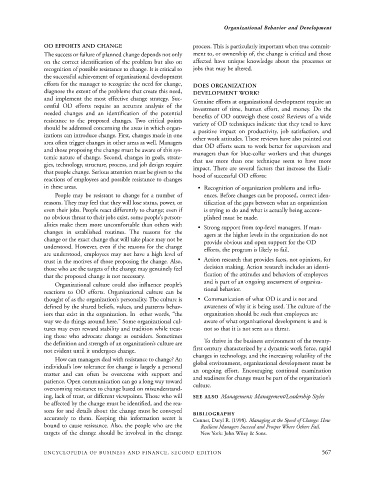Page 590 - Encyclopedia of Business and Finance
P. 590
eobf_O 7/5/06 3:17 PM Page 567
Organizational Behavior and Development
OD EFFORTS AND CHANGE process. This is particularly important when true commit-
The success or failure of planned change depends not only ment to, or ownership of, the change is critical and those
on the correct identification of the problem but also on affected have unique knowledge about the processes or
recognition of possible resistance to change. It is critical to jobs that may be altered.
the successful achievement of organizational development
efforts for the manager to recognize the need for change, DOES ORGANIZATION
diagnose the extent of the problems that create this need, DEVELOPMENT WORK?
and implement the most effective change strategy. Suc- Genuine efforts at organizational development require an
cessful OD efforts require an accurate analysis of the
investment of time, human effort, and money. Do the
needed changes and an identification of the potential
benefits of OD outweigh these costs? Reviews of a wide
resistance to the proposed changes. Two critical points
variety of OD techniques indicate that they tend to have
should be addressed concerning the areas in which organ- a positive impact on productivity, job satisfaction, and
izations can introduce change. First, changes made in one
other work attitudes. These reviews have also pointed out
area often trigger changes in other areas as well. Managers
that OD efforts seem to work better for supervisors and
and those proposing the change must be aware of this sys- managers than for blue-collar workers and that changes
temic nature of change. Second, changes in goals, strate- that use more than one technique seem to have more
gies, technology, structure, process, and job design require impact. There are several factors that increase the likeli-
that people change. Serious attention must be given to the
hood of successful OD efforts:
reactions of employees and possible resistance to changes
in these areas. • Recognition of organization problems and influ-
People may be resistant to change for a number of ences. Before changes can be proposed, correct iden-
reasons. They may feel that they will lose status, power, or tification of the gaps between what an organization
even their jobs. People react differently to change; even if is trying to do and what is actually being accom-
no obvious threat to their jobs exist, some people’s person- plished must be made.
alities make them more uncomfortable than others with
• Strong support from top-level managers. If man-
changes in established routines. The reasons for the agers at the higher levels in the organization do not
change or the exact change that will take place may not be provide obvious and open support for the OD
understood. However, even if the reasons for the change
efforts, the program is likely to fail.
are understood, employees may not have a high level of
trust in the motives of those proposing the change. Also, • Action research that provides facts, not opinions, for
those who are the targets of the change may genuinely feel decision making. Action research includes an identi-
that the proposed change is not necessary. fication of the attitudes and behaviors of employees
and is part of an ongoing assessment of organiza-
Organizational culture could also influence people’s
tional behavior.
reactions to OD efforts. Organizational culture can be
thought of as the organization’s personality. The culture is • Communication of what OD is and is not and
defined by the shared beliefs, values, and patterns behav- awareness of why it is being used. The culture of the
iors that exist in the organization. In other words, “the organization should be such that employees are
way we do things around here.” Some organizational cul- aware of what organizational development is and is
tures may even reward stability and tradition while treat- not so that it is not seen as a threat.
ing those who advocate change as outsiders. Sometimes
the definition and strength of an organization’s culture are To thrive in the business environment of the twenty-
not evident until it undergoes change. first century characterized by a dynamic work force, rapid
changes in technology, and the increasing volatility of the
How can managers deal with resistance to change? An
global environment, organizational development must be
individual’s low tolerance for change is largely a personal
an ongoing effort. Encouraging continual examination
matter and can often be overcome with support and and readiness for change must be part of the organization’s
patience. Open communication can go a long way toward
culture.
overcoming resistance to change based on misunderstand-
ing, lack of trust, or different viewpoints. Those who will SEE ALSO Management; Management/Leadership Styles
be affected by the change must be identified, and the rea-
sons for and details about the change must be conveyed
BIBLIOGRAPHY
accurately to them. Keeping this information secret is Conner, Daryl R. (1998). Managing at the Speed of Change: How
bound to cause resistance. Also, the people who are the Resilient Managers Succeed and Prosper Where Others Fail.
targets of the change should be involved in the change New York: John Wiley & Sons.
ENCYCLOPEDIA OF BUSINESS AND FINANCE, SECOND EDITION 567

